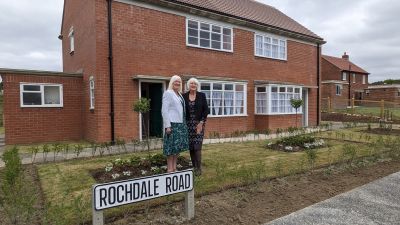Sunderland sisters' childhood home rebuilt in expansion of Beamish 1950s town

Two sisters can now walk through their childhood home from the 1950s again as a replica opens at Beamish Museum in County Durham.
The museum has opened new exhibits in its 1950s town including houses, a police office, and a bowling green all based on buildings that were once in the North East.
From Friday 9 June, visitors can experience semi-detached council houses from Red House in Sunderland, police houses and office from Leam Lane in Gateshead, and a bowling green and pavilion from Billingham.
Linda Gilmore and Brenda O’Neill’s childhood home won a public vote to be copied after being nominated on behalf of their mother Esther Gibbon. Sadly, Esther died in December 2019 but the museum continued to work with her daughters to recreate the semi-detached house they grew up in at Rochdale Road in Sunderland.
Linda, who was born in the house in 1958, said: “It’s absolutely amazing. Coming into the house has brought back so many memories.
“It’s very emotional for me. I was born into a very happy family and to actually be able to have this house rebuilt and the history of our family kept alive forever – it is a very emotional moment for me.”
She added: “The staff and everybody involved in the project, they’ve done a fabulous job, a great big thank you.”
Brenda added: “It’s such a massive privilege. My mam absolutely loved this house, it was like somebody gave her the best thing ever in her life. That’s just so important for me, that my mam will be remembered for who she was and the kind of life she had and it was a happy place and that’s wonderful.”
The second house will tell the story of Polish migration into the region following the Second World War. Beamish has been working with Ray Malecki, whose late father Roman was born in Poland and settled as a miner in Ashington after the war.
Ray said: “It’s wonderful to be able to share my dad’s story. He was a lovely guy, got on with people very, very well. I’ll be delighted to bring my family and see the exhibit."
The new 1950s exhibits are part of the Remaking Beamish project, which is the biggest development in Beamish’s history, funded by £10.9 million from The National Lottery Heritage Fund in 2016.
Rhiannon Hiles, Beamish’s Chief Executive, said: “It has been such an honour for the museum to work with families and communities to share these important stories of life in the region and preserve this heritage for future generations.
“We’re really looking forward to welcoming our visitors to explore the newest additions to Beamish.”
Two police houses and their associated office, from Leam Lane in Gateshead, have been copied to tell the story of 1950s policing and the lives of officers and their families. The museum worked with Councillor John Shuttleworth who, as the son of a police officer, grew up in one of the police houses replicated by the museum. The museum also worked closely with the North East Police History Society (NEPHS).
The bowling green and pavilion, replicated from John Whitehead Park in Billingham, will give visitors the chance to try this popular 1950s sport. The John Whitehead Park Bowling Club was built in the early 1950s by Billingham Urban District Council. A men’s club formed in 1953, followed two years later by a women’s club, and the teams later merged to become Billingham Bowling Club, which is still in existence.
Beamish has worked with the club to learn more about its history and the pavilion, as well as speaking to other local clubs, who have all shared their knowledge to help tell the story of bowling in the 1950s. Billingham Bowling Club will take part in the first official game on the new green at the opening celebrations on 9 June.
The Remaking Beamish project’s 1950s Town also includes a replica of Leasingthorne Colliery Welfare Hall and Community Centre, Coronation Park and Recreation Ground, Front Street terrace with Elizabeth’s Hairdresser’s, Middleton’s fish and chip shop, John’s Café and a recreation of artist Norman Cornish’s house.
Helen Featherstone, Director, England, North at The National Lottery Heritage Fund, said: “We are very excited to see another element of the Remaking Beamish project come to life, thanks to National Lottery players. These amazing new exhibits that have been created by working with local people to uncover stories, will give visitors the chance to explore the heritage of the North East and truly understand what life would have looked like in the 1950s.”
Want a quick and expert briefing on the biggest news stories? Listen to our latest podcasts to find out What You Need To Know.